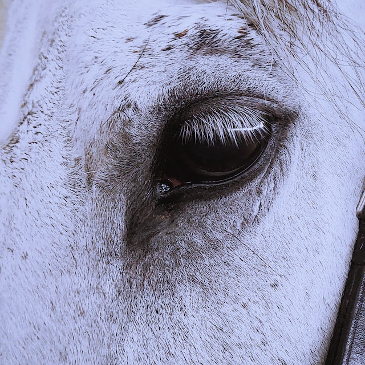I’m writing this not long after the 2023 Grand National horse race in the UK because, for some reason, the gruesome spectacle touched me even more so than usual. It’s obvious these animals are pushed to painful limits at events like this but I started wondering, do horses feel pain when you ride them in ‘normal’ situations? Well, it turns out there are studies into this exact issue.
Do Horses Feel Pain When You Ride Them?
Yes, horses do feel pain when you ride them. Despite what you may have been told by ‘industry experts’ it’s been proven categorically that many horses which are deemed fit to compete in events actually show lameness when the jockey climbs on board. In other words, they feel pain when ridden.
Watch: Guardian Sport on the 2023 Grand National Horse Deaths
(this is a really quick 2 minute look at the events that day)
Related: “Where Do Vegans Draw The Line?” (4 minute read; new tab opens)
Horse Riding & Cruelty : Inextricably Linked?
Horses naturally love to run and having someone clinging to their body is the ideal situation … thought no horse, ever.
Horses do not naturally let humans climb on their back and ride them.
Every single horse you see with a rider perched up there on the saddle has had to be ‘broken in’ … just the phrase alone speaks to the inherent cruelty in this act.
To break a horse in literally means to break the animal’s spirit. The human ‘trainer’ will attempt to remove the wild from the horse so it becomes subservient and more passive.The techniques used often cause pain and severe anxiety.
Of course, equestrian groups will strongly disagree with this sentiment and enthusiastically affirm there are methods to break a horse which are not cruel.
… they would say that.
But too often horses are broken in using methods which are unarguably cruel. Things like tying the reins too tightly and withholding sustenance sometimes for days to weaken the animal before beginning the process.
Then there is just blatant violence involved when the ‘trainer’ beats the horse if they do not respond in the desired way. It’s basically animal torture.
So before the horse can even be ridden, there is often a degree of cruelty involved. But what about when the animal gives in and allows a person to climb onboard?
The Industry Has a Very Low Bar
In a revealing 2016 study into horse lameness, renowned equine vet Dr Sue Dyson published proof [1] that the industry considers lame animals to be perfectly fit for competition.
 Using a comprehensive method to measure lameness, of the 57 working sports horses, 47% were shown to be lame when ridden. These animals were considered healthy enough to perform competitively.
Using a comprehensive method to measure lameness, of the 57 working sports horses, 47% were shown to be lame when ridden. These animals were considered healthy enough to perform competitively.
So the industry’s own measure of lameness failed to pick up the issues. This means those horses did indeed feel pain when they were being ridden. It’s fair to conclude that all horses likely feel pain when you ride them.
As a side note, you may have read that Dr Dyson was struck off the veterinary register here in the UK. This by no means invalidates her extensive work in the area and the circumstances of her disciplinary action were a little suspect by any measure.
Let’s just say … some people didn’t like the research she was publishing at the time!
What would it do to the horse racing industry if it could be shown that riding a horse causes the animal pain? Not great for the welfare concerns hey?
A $122 Billion Industry In The US Alone
I had no idea how huge the equine market is before I started doing some research for this article. A 2017 study estimated the US industry to be worth a whopping $122 billion USD.
That’s huge!
Racing is by far the largest sector, accounting for 42% of the total. Working horses took only 5% of the market with competition and recreation at 32% and 21% respectively.
From these figures we can see that 95% of the market is dedicated to nothing more than satisfying our desire to be entertained. It’s no wonder horse welfare plays second fiddle to the financial concerns of the industry.
Figures vary but according to a 2006 article in the Pittsburgh Post Gazette, as many as 800 racehorses are put to death annually in the US due to injuries sustained in the ‘sport’.
… and for what?
So someone can wear a silly hat on race day and throw some money down the drain on a flutter. Honestly … I despair of the human race sometimes.
Most of these injured horses could be looked after and allowed to live out the rest of their natural lives. But that costs money and since the pursuit of profit is the #1 consideration, destroying the animal is the most economical option.
As usual, money trumps animal welfare.
Vegans Reject Using Horses For Pleasure
Horse racing and the wider equine industry is embedded with cruelty and is something all vegans should reject outright.
 An interesting debate flared up on Twitter recently when celebrity vegan Joaquin Phoenix decided (again) that it was ok for him to ride a horse for his latest movie.
An interesting debate flared up on Twitter recently when celebrity vegan Joaquin Phoenix decided (again) that it was ok for him to ride a horse for his latest movie.
I started out thinking it was just about excusable considering all the work Phoenix has done for veganism but I was soon convinced that he should have refused to do it. Especially considering he apologized profusely the last time he did the exact same thing!
Veganism is about opposing animal exploitation in all its forms. Riding horses for our own pleasure and amusement is exploitation, plain and simple. It’s something we could easily choose not to do.
… and so that is what we should choose.
If you’re considering going vegan because you are upset by the way humans treat animals then I urge you to at least give it a try. Why not commit to 30 days and see how you get on? Your conscience will certainly thank you for it.
(just pay attention to your nutritional needs and supplement with omega 3, vitamin B12 and vitamin D. Your health does not need to suffer to make a stand against animal cruelty)
I hope this article has helped answer your question and if you have any comments I’d love to hear them. Please send in your thoughts below (I always reply) and we would welcome a share on the socials. Spread the love!
Lastly, if you enjoyed this piece why not sign up to our new post alerts mailing list? We’ll alert you when there’s new content published and we will never spam you.
Thanks for reading and have a peaceful day.
Rohan.
[1] Sue Dyson, Line Greve. Subjective Gait Assessment of 57 Sports Horses in Normal Work: A Comparison of the Response to Flexion Tests, Movement in Hand, on the Lunge, and Ridden. Journal of Equine Veterinary Science. Volume 38, 2016, Pages 1-7. ISSN 0737-0806 https://doi.org/10.1016/j.jevs.2015.12.012.
